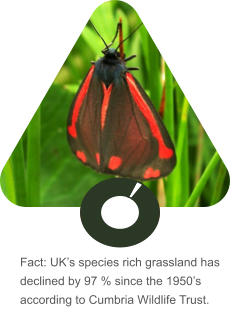


.
Wildlife needs meadows and verges
The fells and dales have a multitude of different grassland habitats and the hay meadows and road verges are crucially important for a wide variety of wild plants and animals.
In 2011 Cumbria Wildlife Trust worked with farmers in the The Westmorland
Fells and Lake Distict National Park project area to conserve and restore
traditional hay meadows.
The HayDay project was established to identify where these flower rich
meadows are in the county, and then to work with farmers, smallholders and
community groups to enhance, restore and manage these meadows using
traditional practices to increase plant diversity.
Restoration and conservation of hay meadows provides vital habitat for native
wildlife. Traditional upland hay meadows are important for wildlife diversity being
home to a profusion of wildflowers and co-dependent pollinating insects. The Above
images are prize winning entries from Cumbria Wildlife Trust’s 2009 Hay meadow
photographic competition.

Westmorland Fells’
Hay Meadows

Hay Meadows
Westmorland Fells and The
Hay-Day Project

Cumbria Wildlife Trust Hayday Project
Header image Rob Grange Photography
In Westmorland Cumbria Wildlife Trust has surveyed meadows, restored many
by adding wildflower seed, provided input into Farm Environment Plans/HLS
agreements, helped meadows get designated as new County Wildlife Sites,
established seed donor sources and provided management guidance.
View their page on Meadow Life.
View Westmorland Dales Landscape
Partnership campaign to increase species
rich grassland.

97%
Grassland is also important for carbon sequestration to
fight climate change and maintaining local watershed
dynamics.
Advertisement

© This site and its contents are copyright 2010-22 by C.Paxton and other contributing members of the Westmorland Fells Group.


Hay Meadows

Celebrating Cumbria’s Carboniferous Fells and Dales
Wildlife

In 2011 Cumbria Wildlife Trust worked with farmers in the The
Westmorland Fells and Lake Distict National Park project area to
conserve and restore traditional hay meadows.
The HayDay project was established to identify where these flower rich
meadows are in the county, and then to work with farmers, smallholders
and community groups to enhance, restore and manage these meadows
using traditional practices to increase plant diversity.


Restoration and conservation of hay meadows provides
vital habitat for native wildlife. Traditional upland hay
meadows are important for wildlife diversity being home
to a profusion of wildflowers and co-dependent pollinating
insects. The Above images are prize winning entries from
Cumbria Wildlife Trust’s 2009 Hay meadow photographic
competition.

Westmorland Fells and The
Hay-Day Project
In Westmorland Cumbria Wildlife Trust has surveyed meadows, restored
many by adding wildflower seed, provided input into Farm Environment
Plans/HLS agreements, helped meadows get designated as new County
Wildlife Sites, established seed donor sources and provided management
guidance.
View their page on Meadow Life.
View Westmorland Dales Landscape
Partnership campaign to increase species
rich grassland.

97%
Cumbria Wildlife Trust Hayday Project
Small Blue
Grassland is also important for carbon
sequestration and local watershed dynamics.
Advertisement


© This site and its contents are copyright 2010-22 by C.Paxton and
other contributing members of the Westmorland Fells Group.




















